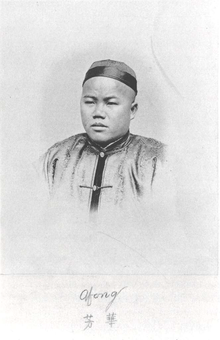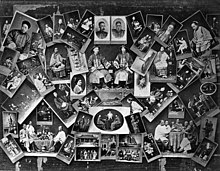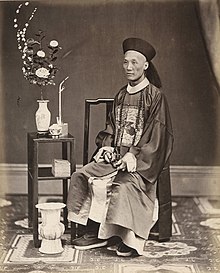Lai Afong
Lai Afong | |
|---|---|
 Lai Afong. c. 1870 | |
| Born | 1838 or 1839[1] |
| Died | (aged 51)[1] Hong Kong |
| Other names |
|
Lai Afong(Chinese:Lê phương;c. 1838 or 1839 – 1890) was a Chinese photographer who established Afong Studio, considered to be the most successfulphotographic studioin the lateQing dynasty.[1]He is widely acknowledged as the most significant Chinese photographer of the nineteenth century.[2][1][3]
Life and work
[edit]
Lai Afong was born inGaoming,Guangdongand arrived inHong Kongin the 1850s as a refugee of theTaiping Rebellion.[4]It is not known how he learned thewet-plate collodionprocess,[5]but, it is said that by as early as 1859 had learned the art of photography.[6]At some point between 1865 and 1867, Lai Afong worked at the Hong Kong studio of Portuguese photographer José Joaquim Alves de Silveira; by 1870, the earliest known announcement of the Afong Studio was printed as an advertisement in theHong Kong Daily Press.[1]Lai Afong's subject matters ranged from portraits and social life pictures to cityscapes and landscapes.[7]Little is known about his life, although many of his images survive today as testament to his extraordinary talent.[2]After Lai Afong's death, the business was taken over by his son in the 1890s.[8]
Lai Afong traveled through the provinces ofFu gian,Guangdong,Hebei,Song gian g (todayShanghai), andHong Kong,creating photographs. His collection of views included photographs of masterpieces ofChinese architecturesuch as sites within theSummer Palaceand theFragrant Hills PagodainBeijing,theTemple of the Six Banyan TreesinGuangzhou,and numerous others, as well as magnificentpanoramasof such locations asVictoria harborandGulangyu island.As Lai Afong’s reputation quickly grew, both Chinese and foreign clientele flocked to his studio for portrait sessions, including some of China’s most important people such asQing dynastyofficialLi Hongzhang.[9]According to the verso of many of hisCarte de visiteworks, he was photographer toGovernor of Hong KongSir Arthur Kennedy KCBandGrand Duke Alexei Alexandrovich of Russia.[7]

Lai Afong was the most successful of his generation of Chinese photographers in appealing to both a Chinese and foreign cosmopolitan clientele.[7]Lai Afong advertised in English-language newspapers – offering a “Larger, and more complete collection of Views than any other Establishment in the Empire of China”[10]– and the artist captioned much of his work in both Chinese and English.[11]Afong Studio photographs were sold to both Chinese patrons – both those local toHong Kongand those visiting from other parts of China – and foreign visitors to China.[2]
The Afong Studio became a destination and training ground for foreign photographers in the region, and photographers such as Emil Rusfeldt and D.K. Griffith began their careers under the tutelage of Lai Afong.[6]In 1875, Griffith claimed that his mentor had “entered the arena of European art, associating his name with photography in its best form, and justly stands first of his countrymen in Hong Kong.”[1]John Thomson,a Scottish photographer working in China at the time, praised Lai Afong’s images as “extremely well-executed, [and] remarkable for their artistic choice of position," in his bookThe Straits of Malacca, Indo-China, and China.[12]
Lai Afong seems to have been the only Chinese photographer of his generation to be embraced by his foreign contemporaries.[1]However, his work is distinct among them, as many of Lai Afong’s photographic compositions show the technical and aesthetic influence of traditionalChinese painting,known as guóhuà.[13]Additionally, Lai Afong favored thepanoramamore than any other photographer working in China in the 19th century, earning his work a place among the giants of 19th centurylandscape photographysuch asCarleton Watkinsin America andGustave Le Grayin France.[14]No other nineteenth-century Chinese photographer offered as extensive and diverse a view of lateQing dynastyChina.[3]
Legacy
[edit]
In February 2020, theJohnson Museum of ArtatCornell UniversitypresentedLai Fong (Ca. 1839-1890): Photographer of China,the first museum exhibition dedicated to Lai Fong.[15]The majority of the photographs exhibited were on loan fromStephan LoewentheilChina Photography Collection,one of the world's foremost collections ofEarly Chinese Photography.[16]Although in-person viewing was cut short by theCOVID-19 pandemic,the exhibition received praise from international news outlets such as China’s largest newspaper,People’s Dailyfor “truly [showing] the life of Chinese society in the 19th century, telling the story of China in that era”[9]and inFine Books and Collectionsfor showcasing "magnificent views of a rapidly growing Hong Kong, Guangzhou, Beijing, Shanghai, Fuzhou, and Xiamen, and important early portraits of the diverse people of lateQing DynastyChina. "[17]
As the most successful Chinese photographer of his time period,[7]Lai Afong’s photographs offer a rare opportunity to view China and its people through the eyes of a Chinese artist, before the transformations of the twentieth century would change the country forever. After languishing in near obscurity for decades after his death, the presence of his work in archives such as theStephan LoewentheilChina Photography Collectionhas helped to expose Lai Afong to a wider contemporary audience. Lai Afong’s photographs are currently held in the permanent collections of theMetropolitan Museum of Art,[18]theJ. Paul Getty Museum,[19]theNational Galleries of Scotland,[20]and several other prominent museum collections.[5][21][22]
Identifying Afong Studio photographs
[edit]
Several obstacles make it difficult to reliably identify the artists who photographed nineteenth-century China: the scarcity of material which is scattered around the world is seldom correctly recorded or catalogued, and the few identifiers and indexes that exist (artist, studio, location, etc.) are often erroneous.[23]When early photographers went out of business or left China, the contents of their studios (including theirglass plate negatives) were sold or auctioned off, and were often acquired by other photographers working in China who would then make new prints from the negatives to be incorporated into their own stock.[1]Furthermore, especially in a country as large as China, travelers would often purchase photographs by several photographers they visited throughout their trips, and would combine them into a single album upon their return.[23]As such, 19th century photograph albums, even those bearing the label of a particular studio, are often the work not only of that studio, but of several other unaccredited photographers as well.[23]
Despite Lai Afong's prominence, relatively few works can be securely identified as being from his hand.[24]The scarcity of original photographs and absence of archival records make it challenging to identify Lai Afong’s work.[1]Although photographs printed from Lai Afong’s own negatives dominated his photography studio’s production, The Afong Studio was known to occasionally include prints from negatives made by other photographers in albums it produced. This phenomenon extended to other studios as well, and Lai Afong’s photographs would often find their way into albums produced by other studios, or into albums assembled by the purchasers of the prints. Since Lai Afong was a “master photographer with a highly attuned artistic sense,” he only incorporated work from well-regarded foreign photographers – such as Milton Miller,John Thomson,andDutton & Michaels.[1]For example, the albumPeople and Views of China,attributed to Lai Afong, contains images from Milton Miller, St. John Edwards, and other unidentified photographers. However, as Lai Fong expanded his collection of views through extensive photographic expeditions, he replaced the negatives by others with his own views. Afong Studioalbumscreated after circa 1880 appear to contain few or no images from other photographers.[1]
Gallery
[edit]- Selected photographs by Lai Afong (Note: See more of Lai's images on Wikimedia Commons)
-
Panorama ofGulangyu IslandandAmoy
-
A commercial street inGuangzhou
-
studio portrait
Albums
[edit]- Album of photographs of Peking and its environs
- An album mainly of landscape photographs of China
- From Afong, Photographer
- Images related to Shanghai and other Chinese cities
- People and views of China
See also
[edit]Chinese language sources
[edit]- *Lạc Văn Hill Trung Quốc nhiếp ảnh cất chứa
- Đại học Thanh Hoa nghệ thuật viện bảo tàng, Lạc Văn Hill cất chứa biên. Thế sống chung ánh giống —— Lạc Văn Hill nhiếp ảnh cất chứa trung 19 thế kỷ Trung Quốc [C]. Bắc Kinh: Đại học Thanh Hoa nhà xuất bản, 2018.
- [ anh ] thái thụy · Bennett. Trung Quốc nhiếp ảnh sử: Trung Quốc nhiếp ảnh gia 1844-1897[M]. Từ đình đình dịch. Bắc Kinh: Trung Quốc nhiếp ảnh nhà xuất bản, 2014.
- [ anh ] thái thụy · Bennett. Trung Quốc nhiếp ảnh sử: 1842-1860 [M]. Từ đình đình dịch. Bắc Kinh: Trung Quốc nhiếp ảnh nhà xuất bản, 2011.
References
[edit]- ^abcdefghijklBennett, Terry (2013).History of Photography in China: Chinese Photographers 1844–1879.London: Bernard Quaritch.ISBN978-0956301246.Archived fromthe originalon 28 June 2017.Retrieved28 June2017.
- ^ab"Lai Fong (Afong Studio)".HCP Bristol.Retrieved18 September2020.
- ^"Lai Fong (ca. 1839-1890): Photographer of China".Cornell University Johnson Museum of Art.Retrieved31 August2020.
- ^ab"Western man in Hong Kong in Chinese costume c. 1885".National Galleries of Australia.Retrieved17 September2020.
- ^abYuan, Feng; Mingzhi, Wang, eds. (2018).Vision and Reflection: Photographs of China in the 19th Century from the Loewentheil Collection.Beijing: Tsinghua University Press. p. 185.ISBN978-7-302-51668-2.
- ^abcdFarmer, Hugh."Lai Afong lại a phương and Afong Studio, early HK photographic studio".The Industrial History of Hong Kong Group.Retrieved2 September2020.
- ^Newton, Gael."Local heroes of early photography in Asia and the Pacific".National Galleries of Australia.Archived fromthe originalon 28 March 2016.Retrieved1 September2020.
- ^abZhang, Jinyang; Hou, Xingchuan."The First Exhibition of Works of by the Pioneering Chinese Photographer Lai Fong at the Johnson Museum of Art, Cornell University"(PDF).People's Daily (translated by the Loewentheil Collection).Retrieved18 September2020.
- ^Cody, Jeffery W.; Terpak, Frances, eds. (2011).Through a Foreign Glass: The Art and Science of Photography in late Qing China.Los Angeles, California: Getty Research Institute.ISBN978-1-60606-054-4.
{{cite book}}:|journal=ignored (help) - ^Lee, Anthony W. (30 May 2019).The Global Flows of Early Scottish Photography: Encounters in Scotland, Canada, and China.McGill-Queen's University Press. p. 272.ISBN978-0773557130.
- ^Thompson, John (1875).The Straits of Malacca, Indo-China, and China.Harper & brothers. pp. 188–189.Retrieved11 November2015.
- ^Meccarelli M."New Perspectives about the Origins of Chinese Photography and Western Research in China"inArte Dal Mediterraneo al Mar Della Cina – Genesi ed incontri di scuole e stili. Scritti in onore di Paola Mortari Vergara Caffarellieds. P. Fedi-M. Paolillo, Officina di Studi Medievali, Palermo, 2015, pp. 587–598
- ^Cody, Jeff."Brush and Shutter: When Chinese Painters Became Photographers".The Iris.Retrieved17 September2020.
- ^"Herbert F. Johnson Museum of Art opens the first exhibition of 19th century photographer Lai Fong".Art Daily.Retrieved16 July2020.
- ^"Exhibition Highlight | Lai Fong: Photographer of China".Photography of China.Retrieved16 July2020.
- ^"First Exhibition of Nineteenth-Century Chinese Photographer Lai Fong Opens in Ithaca".Fine Books and Collections.Retrieved18 September2020.
- ^"Search the Collection: Lai Fong".The Metropolitan Museum of Art.Retrieved18 September2020.
- ^"People and views of China, [ca. 1860-ca. 1900]".Getty Library Catalogue.Retrieved18 September2020.
- ^"Afong Lai".National Galleries Scotland.Retrieved18 September2020.
- ^"Lai Afong".SF MOMA.Retrieved18 September2020.
- ^"Collections: Lai Afong".Princeton University Art Museum.Retrieved18 September2020.[permanent dead link]
- ^abcThiriez, Regine (17 May 2019).Barbarian Lens, Western Photographers of the Qianlong Emperor's European Palaces.Routledge.ISBN978-1138002234.
- ^Wue, Roberta.Essentially Chinese – The Chinese Portrait Subject in Nineteenth-Century Photography(PDF).Cambridge, Mass.: Harvard University Asia Center. p. 267. Archived fromthe original(PDF)on 12 March 2021.Retrieved8 October2020.
Further reading
[edit]- Bennett, Terry (2009).History of Photography in China 1842–1860.Bernard Quaritch.ISBN978-0-9563012-0-8.
- Bennett, Terry (2013).History of Photography in China: Chinese Photographers 1844–1879.London: Bernard Quaritch.ISBN978-0956301246.Archived from the original on 28 June 2017.Retrieved28 June2017.
{{cite book}}:CS1 maint: bot: original URL status unknown (link) - Chen, Shi (2009).Early Chinese Photographers from 1840 to 1870: Innovation and Adaptation in the Development of Chinese Photography(PDF)(Master of Arts thesis).University of Florida.Retrieved26 February2015.
- Cody, Jeffery W.; Terpak, Frances, eds. (2011).Brush & Shutter: early photography in China.Los Angeles, California: Getty Research Institute.ISBN978-1-60606-054-4.
- Yuan, Feng; Mingzhi, Wang, eds. (2018).Vision and Reflection: Photographs of China in the 19th Century from the Loewentheil Collection.Beijing: Tsinghua University Press.ISBN978-7-302-51668-2.







